For digital marketers, content marketing and link building are vital for each and every one of our campaigns. Some of the challenges we face during these campaigns are getting links to our content, developing content that people want to share, or simply finding the time to build links to our content.
Here’s the thing. If you have an incredible content marketing plan in place and effectively reach out to influential bloggers in your industry, you’ll also earn those backlinks. That’s not saying it won’t take some time and effort on your end – it will.
What I am saying is that you can get smarter about how you go about link building by earning links through quality content and blogger outreach.
What is Link Building?
The most basic definition for link building is the process of acquiring hyperlinks from other websites to your website. When it comes to SEO, link building is important because search engines rely on links to discover new web pages and determine how and where a page will rank in search results. Without links, you can’t get ranked on a search engine like Google. And if your site isn’t found, then no one is going to notice the content you are working so hard to produce.
Additionally, link building can also assist with building your brand through:
- Authority signal building: Earning links from reputable and relevant industry websites or social media channels will help position your brand as a leading authority figure.
- Branding, influencing, and positioning your company: Again, quality links can help position your brand in the minds of your customers by proving you are a trusted leader in your industry.
Content marketing and link building can work hand-in-hand because links are actually the byproduct of great content marketing. For example, if you’re involved with digital marketing and publish a blog post or infographic regarding a recent study, your initial plan wasn’t to obtain links.
It was to produce and share something valuable for your audience. The content, because it’s so incredible that it could rank itself, will be shared by industry leaders and publications. That one piece of content could then earn you a couple of quality links, which in turn boosts your credibility and helps attract more links or signals.
What Link Building is Not
Because link building has been effective in the past in helping websites achieve higher rankings on search engines, it was only a matter of time before people began manipulating the system. Google has since cracked down on these link schemes by penalizing websites who have bought links or participated in extensive link exchanges.
If you want to acquire links, and don’t want to face the wrath of Google, keep in mind that link building is about earning links and not taking a shortcut by trying to obtain links just for the purpose of gaining links by:
- Article distribution sites: Google’s Matt Cutts has recommended not uploading your content onto article distribution sites.
- Guest blogging networks: Guest blogging is a great way to expand your brand and gain exposure, however, using a guest blogging network for links could put you in the dog house with Google.
- Link wheels: This is an artificial way to build links through a circular pattern of links.
- Private blog networks: Google has also been targeting PBNs and considers the content on these sites spam.
- Mass link swapping: Google will penalize you if you partake in an excessive amount of link exchanges.
- Link injections: Being sneaky and trying to hide a link to your website is a big no-no.
How to Build Links
One of the most effective ways to build links is by having what I call a “link magnet” on your site. Let’s say you run an e-commerce site. What kind of link magnets could you have on your site that would normally just contain product pages?
Here are a couple of ideas for content that attracts links:
- Daily blog posts
- Resource centers
- Galleries
- Reviews
- Comparisons
- White papers or Ebooks
- Infographics
An example of a brand that has accomplished this is outdoor clothing brand Patagonia brand. When the company first launched, it’s website contained content like guides, maps, and contributed stories that focused on outdoor adventures. The other half of the site simply featured product pages.
This was a great way to for an e-commerce site to tap into the lifestyle of its customers by creating content that they would like.
Not all types of pages of can attract links, though. For example, product listings, product categories, boring press releases, and ‘about’ pages are typically not the types of content that people will link to. If you’re a publisher or blogger and you receive an email from someone asking for a link to a press release or product page, your response should immediately be “no”, since these types of pages normally don’t receive natural links.
Keyword Research and Data Tools
Realizing you need to create content that hooks your audience is one thing. Creating the exact type of content they are looking for is another. That’s why before you begin creating any sort of content, you should do your due diligence and understand what exactly it is your audience is looking for.
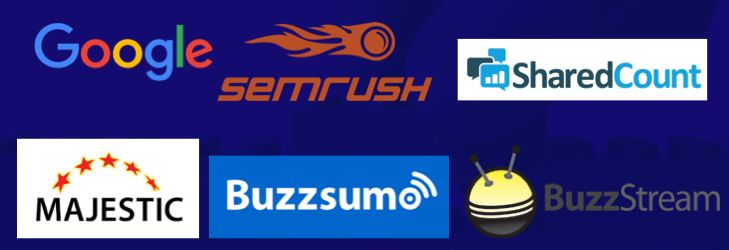
You can achieve that by using the following powerful keyword research and data tools to generate content ideas and reach out to influencers.
Google has plenty of tools for marketers, like AdWords, but you can conduct a simple search query to discover popular search results in your industry. Since Google is the most visited website in the world, you’ve probably seen this in action hundreds of times before. For example, if you began typing in “New York” Google will autocomplete the rest with suggestions like “New York Times” or “New York Company.” These suggestions are based on actual searches and how people search Google. Search results can also vary from your search history and your location.
You can do a simple Google search to discover what your audience is searching for. Knowing this allows you to create content that suits their needs.
SEMRush
This is one the best tools you can use for conducting keyword research. With SEMRush, you’re not only able to do keyword research for your marketing campaign, you can also see your competitors’ best keywords. This tool also tracks changes in position for domains, helps you advertise locally, discover new publishers to work with, and analyzes backlinks.
BuzzSumo
You may have written the greatest blog post of all-time. But what good is it if it isn’t seen by the right people? That’s where BuzzSumo comes in. BuzzSumo is an easy-to-use tool that gives you the ability to see which content is performing in a particular niche with information like Facebook or Twitter shares.
This information can be used to develop content ideas. However, BuzzSumo should also be used to connect with influencers. There’s an influencers tab that gives you information like Page Authority, Domain Authority, and Twitter followers.
Majestic
Majestic is another popular tool for marketers. Unlike some of these other tools mentioned, Majestic focuses on link building by providing information on backlinks. You can use it to identify the top pages that link to your site, the top pages on your site, and your backlink history. You can also use it to discover the same information for your competitors.
SharedCount
Here’s an extremely easy-to-use, and free tool, to track URL or social media shares. Just enter a domain name and that’s it. You quickly have the amount of Facebook likes, shares, and comments, as well as the number of tweets, LinkedIn shares, Pinterest pins, and stumbles on StumbleUpon.
BuzzStream
Building relationships is crucial for both content marketing and link building. BuzzStream makes establishing and maintaining meaningful relationships with influencers and authority figures a breeze. You can use this tool to discover relevant contact information, social profiles, and site information for influencers so that you can begin to reach out them.
Putting Keyword Research and Data Tools to Use: A Travel Link Building Scenario
You have these amazing tools at your fingertips. Let’s see how you can put them into your link building and content marketing campaigns.
Google Word Suggest
Let’s say you run a hotel or travel agency and you’re looking to bring in visitors to the Las Vegas area or rank for Las Vegas tourism. During your research, you discover that in 2012, 11% of visitors to Vegas brought minors with them, meaning that parents are beginning to bring their children to Vegas. That’s a 150% increase within the last decade!
So, how can you tap into this niche of 5 million Las Vegas tourists per year?
The first place where you can start when building content is with Google. As mentioned earlier, Google Word Suggest is an incredible resource because there is plenty of free data based on queries that actual people are searching for. For example, you do a search query for “the best places for kids in Las Vegas.” One of the top results that appears is “best places for toddlers in Las Vegas,” which inspires you to do a little more digging to get some content ideas.
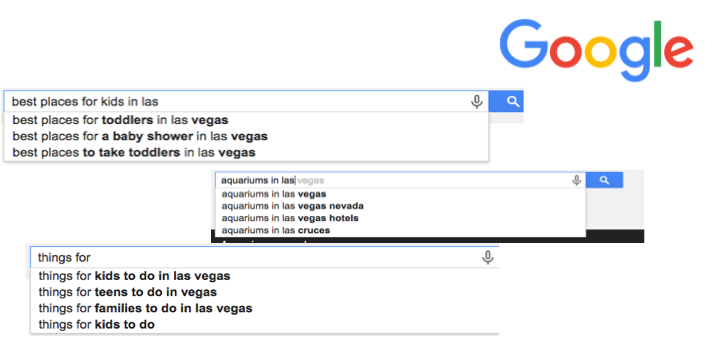
One of the most interesting findings you’ll come across is that Google provides content-based results if you were searching for “best hotels Las Vegas hotels for families. You’ll come across sites like About.com, TripAdvisor, and MiniTime that mention the most kid-friendly hotels in Vegas, but not links to the hotels directly.
This gives you the opportunity to compete or do some outreach with these publications if you produce similar content. Keep in mind, this also clues you into the fact that if you’re a hotel, Caesar’s Palace, for example, your blog’s content may not rank as high as the sites listed above on Google, there is potential to reach out to those blogs or websites.
Google will also provide you with plenty of content ideas and even headlines because when you search for “things to do with kids in Las Vegas,”, the top results that turn up will be “top 10 things for kids to do in Las Vegas,” “things for teens to do in Las Vegas,” “shows for kids in Las Vegas,” “adventuredome,” and “things for kids to do in Las Vegas free.”
This can guide you into creating content people are searching for and can be used to prove to publications that people are searching for this content.
Dig Deeper With More Data
Thanks to Google, you have some content ideas, are aware of what type of content that people are searching for, and the websites or blogs that you could potentially reach out to. You can use SEMRush to track rankings and consolidate search behavior. For example, you can use SEMRush’s Phrase Match Report to identify similar Google search queries and related keywords.
For example, during your Google Word Suggest, you noticed that families were searching for aquariums in Vegas. We can dig a little deeper with SEMRush and discover that the related searches are “shark reef aquarium at mandalay bay las vegas” and “silverton aquarium las vegas.” Essentially, SEMRush is putting together content ideas for us. You could write a blog post like “Top Aquariums For Families To Visit in Las Vegas”.
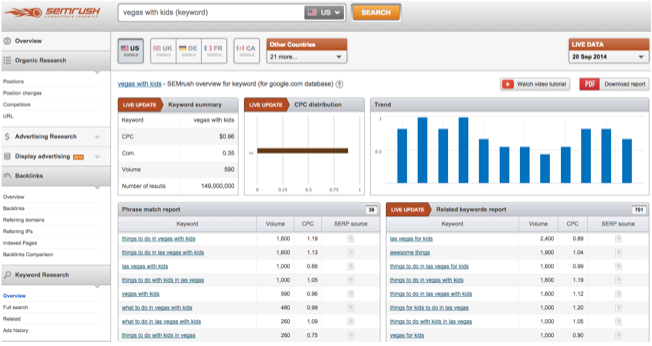
Data Driven Ideation
You have all this amazing data in front of you that includes:
- The kind of content that Google is serving
- The sites Google is serving
- The relevant topic matter people are searching for
- How Google is classifying that topic matter
What are you going to do next with it? You can begin to put together ideas for your content by creating an ideation outline with the data that you have.
For the Las Vegas hotel or travel agency, your ideation outline begins with ‘Things Kids Love in Vegas.’ Since you know that kids love aquariums you could generate content ideas based around:
- ‘Top 10 Aquariums in Las Vegas’
- ‘Top 5 Kids Attractions in Vegas Only Locals Know About’
- ‘Best Kids Destinations off the Vegas Strip’
- ‘Las Vegas: The New Disneyland for Families’
You can then take those ideas and develop it accordingly. For example, you could create an infographic entitled ‘Las Vegas: The New Disneyland for Families’ that you host on your own site. You could create the following supportive content around that infographic:
- ‘Top 10 Aquariums in Las Vegas’ – listicle
- ‘Top 5 Kids Attractions in Vegas Only Locals Know About’ – blog post
- ‘Best Kids Destinations off the Vegas Strip’ – blog post
You can either host this content onto your own blog or place it onto another website. Remember, when developing a content strategy that you can use to acquire links it has the ability the rank because that’s the content people are searching for and what publications are getting traffic from. Building links to a piece of content that doesn’t rank pretty much defeats the purpose of link building and content marketing.
If you’re able to get your content placed on a high authority site like a Huffington Post you’ll increase your chances of receiving links from a smaller sites who are linking back to the content that was placed on the influential site.
Working With Publishers
You did your research. You have content ideas. Now you need to determine the sites that you want to work with. You can search on Google for travel sites that are discussing the same content that you’re producing. Here’s the problem. Those sites are getting hit by other bloggers and websites with the same idea; obtaining links.
By using SEMRush, you have a list of sites that rank for queries, which you can export to an Excel files, and upload that file onto Majestic. Majestic SEO will take those sites, actually 300 sites at a time, will list those links and provide information like topical trust flow, number of backlinks pointing back to the site, and even metrics like trust authority.
You can figure out that there more than 1,000 links pointing back to Mandalay Bay’s website. While it may be difficult to earn a link from Mandalay Bay, you can reach out to those 1,000 websites instead. Chances are, that being included in those sites will be a number of influencers and high-quality websites for you to reach out.
You can also use BuzzSumo to discover high-ranking sites. With BuzzSumo you enter the same search queries, like “las vegas aquariums, and you’ll have access to relevant blog posts, the authors of the blog post, and the amount of social shares that they have received. You can also sort the various types of content that the author publishes. If you have that awesome infographic, you can then just search for authors or websites that publish only infographics.
If you don’t have BuzzSumo, you could go back to Google and do a search on Google News for “travel infographics” to identify travel sites that feature that type of content.
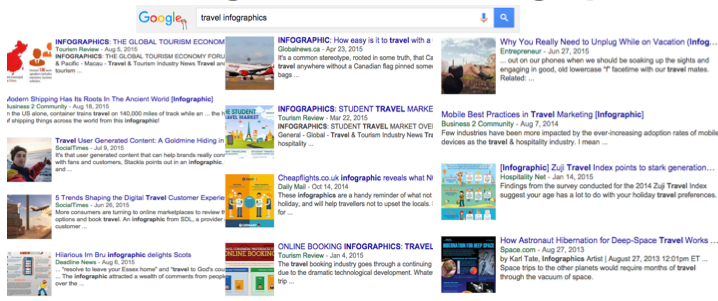
Competitive Intel
Uncovering influencers and publications that are relevant to your content is definitely effective. But, you also need to see what your competitors are up.
You notice that one of your competitors, Travelmath, just released an excellent infographic. You can where their infographic was picked up so that you can get in touch with those publications to see if they’ll pick up your infographic. Even if it isn’t the exact type of infographic, it’s still in the same genre so these are relevant websites.
Using Majestic, you can see where the backlinks for Travelmath’s infographic came from. What’s appealing about using this tool is that you not only can see where the backlinks came from, you can see the amount of backlinks coming from those domains. For example, you’ll notice that links from the site Space.com has 189 different links pointing to that one article. With that information, you know which sites have relevant content and can help you obtain more links. While getting published on a major publication is always a goal, getting an infographic published on Space.com can save yourself a lot of hard work by earning hundreds of quality backlinks from just one publisher.
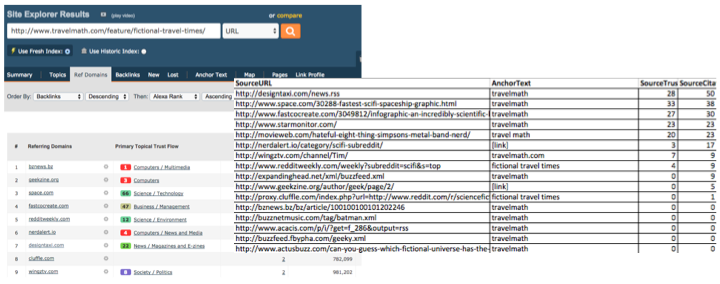
Next up you’ll want to use SharedCount. SharedCount is similar to BuzzSumo, except that it’s free. With this tool, you could do a little more research on the articles published on Space.com. SharedCount will show the amount of Facebook likes, shares, comments, tweets, Google +1s, Pinterest Pins, and LinkedIn shares. Why’s this important? Because if this content is being shared socially it’s getting noticed by influencers, which means you’ll be getting a backlink from their blog or website.
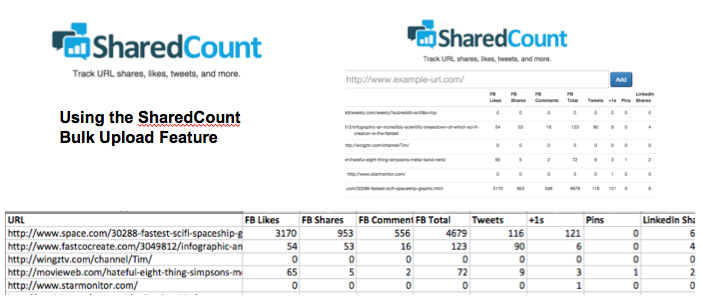
Data pulling can be a lot to digest. But, doing this information can steer you in the right direction for content creation and outreach. To sum this up, here’s a brief recap of how these tools can all work together:
- Google: Can be used to identify what people are searching for.
- SEMRush: Locate quantifiable and exportable data regarding search trends, search volume, and where sites rank for keywords.
- BuzzSumo: Should be used to find influencers.
- Majestic: Allows you to run bulk links on pages ranking for the terms that you identified on SEMRush.
- SharedCount: You can export the information from Majestic to locate social sharing numbers.
There’s one final tool that can be useful for reaching out to influencers, and that’s BuzzStream. Basically, BuzzStream is used to find and manage relationships with influencers by letting you know how to contact authors on social media and see where their content has been published. You can then store that influencer to keep tabs on them. That may sound a bit on the creepy stalker side, but it you see that the influencer is out of town on a vacation for the next week, then you know that now is not the best time to pitch them your content idea.
Besides searching for specific influencers, you can also use BuzzStream for investigating certain websites. BuzzStream will provide info like editors and bloggers so that you know how you need to contact when making your pitch. Since building links so all about building links, it’s probably a better plan to engage with a blogger or editor directly instead of just emailing the generic editor or info email address. BuzzStream can provide that individuals contact information so that you can reach out them personally.
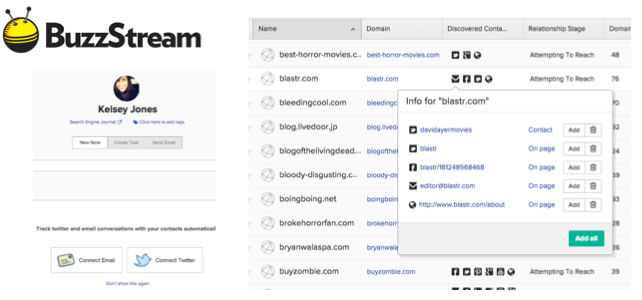
When reaching out to influencers, always remember that these contacts should be cherished and respected. Skip the mass emails and send them a personalized email instead. That shows how much you do value that relationship, and that you actually know who they are. It’s not only a sign of respect when making a warm introduce, you’ll most likely get back a stronger response.
You’ve made the warm introduction, but how can you successfully leverage those relationships with publishers. You can also invite to become a part of the ideation process. Maybe you could have the author co-write an industry White Paper with you. This not only leverages the publisher, it also gets you both exposure to a new audience and the chance to earn some quality links.
Case Study
All of this may sound great in theory, but does it actually work? Yes. And, here’s a top secret case study from an actual client to support that claim:
Client Goals
- Position our client as a national leader in denim amongst 16 to 25-year-old market
- Capitalize on customization of clothing; distressing
- Drive traffic to blog and site for informational and transactional goals
- Dominate organic search queries
Content
- In-depth blog post on distressing denim [much more in depth than competition]
- Infographic visualizing How To’s and DIY Tips [subtle product placement]
- Infograms for social distribution on client social channels [and 3rd party]
- Material for client customer email list [post sale informational tips]
Outreach Targets
- Fashion influencers
- College style influencers
- Denim loyalists
- Industry sites that have covered client initiatives in past
- Influencers who have covered competition posts or similar content
Campaign Results
- 10,000+ Facebook Likes
- 450+ Facebook Shares
- 2,500+ Other Signals from Social Sites
- 25+ Unique Links [High Trust Flow]
- 500+ Co-Citation Links
- 25,000+ Referrals per month from Organic Search
Conclusion
Link building is now all about earning links, and not through black hat practices—at least if you want to prevent getting penalized by Google. If you create quality content that people want to view and share, links will come back to you naturally. You should also personally get in touch with publishers and influencers in your industry to attract additional links. Both methods are a safe and proven way to not only build links, but also build your brand into an established, authority figure.
Want to learn more? Watch the recap video of the webinar I gave to the SEJ ThinkTank a few weeks ago:
Image Credits
Featured image: Mathias Rosenthal/Shutterstock.com
In-post Photo: Jirsak/Shutterstock.com





